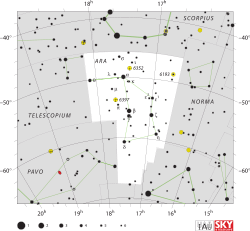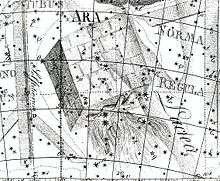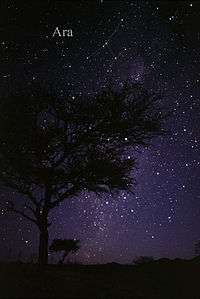Ara (constellation)
| Constellation | |
 | |
| Abbreviation | Ara[1] |
|---|---|
| Genitive | Arae[1] |
| Pronunciation | /ˈɛərə/, genitive /ˈɛəriː/[lower-alpha 1] |
| Symbolism | the Altar[1] |
| Right ascension | 16h 34m 16.9497s–18h 10m 41.3407s[2] |
| Declination | −45.4859734°–−67.6905823°[2] |
| Area | 237 sq. deg. (63rd) |
| Main stars | 8[1] |
| Bayer/Flamsteed stars | 17 |
| Stars with planets | 7 |
| Stars brighter than 3.00m | 2 |
| Stars within 10.00 pc (32.62 ly) | 3 |
| Brightest star | β Ara (2.84m) |
| Messier objects | 0 |
| Meteor showers | None |
| Bordering constellations | |
|
Visible at latitudes between +25° and −90°. Best visible at 21:00 (9 p.m.) during the month of July. | |
Ara (Latin: "The Altar") is a southern constellation situated between Scorpius and Triangulum Australe. Ara (Greek: Βωμός) was one of the 48 Greek constellations described by the 2nd century astronomer Ptolemy, and it remains one of the 88 modern constellations defined by the International Astronomical Union.
The orange supergiant Beta Arae is the brightest star in the constellation, with an apparent magnitude of 2.85—marginally brighter than the blue-white Alpha Arae. Seven star systems host planets. The sunlike star Mu Arae hosts four planets, while Gliese 676 is a binary red dwarf system with four planets. The Milky Way crosses the northwestern part of Ara.
History
In ancient Greek mythology, Ara was identified as the altar where the gods first made offerings and formed an alliance before defeating the Titans.[1] One of the southernmost constellations depicted by Ptolemy,[3] it had been recorded by Aratus in 270 BC as lying close to the horizon, and the Almagest portrays stars as far south as Gamma Arae. Professor of astronomy Bradley Schaefer has proposed that ancient observers must have been able to see as far south as Zeta Arae to define a pattern that looked like an altar.[4]

In illustrations, Ara is usually depicted as an altar with its smoke 'rising' southward.[5] However, depictions of Ara often vary in their details. In the early days of printing, a 1482 woodcut of Gaius Julius Hyginus's classic Poeticon Astronomicon depicts the altar as surrounded by demons.[6] Johann Bayer in 1603 depicted Ara as an altar with burning incense; the flames rise southward as in most atlases. Hyginus also depicted Ara as an altar with burning incense, though his Ara featured devils on either side of the flames. However, Willem Blaeu, a Dutch uranographer active in the 16th and 17th centuries, drew Ara as an altar designed for sacrifice, with a burning animal offering. Unlike most depictions, the smoke from Blaeu's Ara rises northward, represented by Alpha Arae.
Equivalents
In Chinese astronomy, the stars of the constellation Ara lie within The Azure Dragon of the East (東方青龍, Dōng Fāng Qīng Lóng).[7] Five stars of Ara formed Guī (龜), a tortoise, while another three formed Chǔ (杵), a pestle.
Characteristics
Covering 237.1 square degrees and hence 0.575% of the sky, Ara ranks 63rd of the 88 modern constellations by area.[8] Its position in the Southern Celestial Hemisphere means that the whole constellation is visible to observers south of 22°N.[8][lower-alpha 2] Scorpius runs along the length of its northern border, while Norma and Triangulum Australe border it to the west, Apus to the south, and Pavo and Telescopium to the east respectively. The three-letter abbreviation for the constellation, as adopted by the International Astronomical Union, is Ara.[9] The official constellation boundaries, as set by Belgian astronomer Eugène Delporte in 1930,[lower-alpha 3] are defined by a polygon of twelve segments. In the equatorial coordinate system, the right ascension coordinates of these borders lie between 16h 36.1m and 18h 10.4m, while the declination coordinates are between −45.49° and −67.69°.[2]
Features

Stars
Bayer gave eight stars Bayer designations, labelling them Alpha through to Theta, though he had never seen the constellation directly as it never rises above the horizon in Germany. After charting the southern constellations, Lacaille recharted the stars of Ara from Alpha though to Sigma, including three pairs of stars next to each other as Epsilon, Kappa and Nu.[11]
Ara contains part of the Milky Way to the south of Scorpius and thus has rich star fields.[1] Within the constellation's borders, there are 71 stars brighter than or equal to apparent magnitude 6.5.[lower-alpha 4][8]
Just shading Alpha Arae, Beta Arae is the brightest star in the constellation.[13] It is an orange-hued star of spectral type K3Ib-IIa that has been classified as a supergiant or bright giant,[14] that is around 650 light-years from Earth.[15] It is around 8.21 times as massive and 5,636 times as luminous as the Sun.[16] At apparent magnitude 2.85, this difference in brightness between the two is undetectable by the unaided eye.[17] Close to Beta Arae is Gamma Arae, a blue-hued supergiant of spectral type B1Ib. Of apparent magnitude 3.3, it is 1110 ± 60 light-years from Earth.[15] It has been estimated to be between 12.5 and 25 times as massive as the Sun,[18][19] and have around 120,000 times its luminosity.[19]
Alpha Arae is a blue-white main sequence star of magnitude 2.95, that is 270 ± 20 light-years from Earth.[15] This star is around 9.6 times as massive as the Sun,[20] and has an average of 4.5 times its radius.[21] It is 5,800 times as luminous as the Sun,[20] its energy emitted from its outer envelope at an effective temperature of 18,044 K.[21] A Be star, Alpha Arae is surrounded by a dense equatorial disk of material in Keplerian (rather than uniform) rotation. The star is losing mass by a polar stellar wind with a terminal velocity of approximately 1,000 km/s.[20][22]
At magnitude 3.13 is Zeta Arae, an orange giant of spectral type K3III that is located 490 ± 10 light-years from Earth.[15] Around 7–8 times as massive as the Sun, it has swollen to a diameter around 114 times that of the Sun and is 3800 times as luminous.[23]
Delta Arae is a blue-white main sequence star of spectral type B8Vn and magnitude 3.6, 198 ± 4 light-years from Earth.[15] It is around 3.56 times as massive as the Sun.[24]
Eta Arae is an orange giant of apparent magnitude 3.76.
Exoplanets have been discovered in seven star systems in the constellation. Mu Arae (Cervantes[25]) is a sunlike star that hosts four planets. HD 152079 is a sunlike star with a planet. HD 154672 is an ageing sunlike star with a Hot Jupiter. HD 154857 is a sunlike star with one confirmed and one suspected planet. HD 156411 is a star hotter and larger than the sun with a gas giant planet in orbit. Gliese 674 is a nearby red dwarf star with a planet. Gliese 676 is a binary star system composed of two red dwarves with four planets.
Deep-sky objects
The northwest corner of Ara is crossed by the galactic plane of the Milky Way and contains several open clusters (notably NGC 6200) and diffuse nebulae (including the bright cluster/nebula pair NGC 6188 and NGC 6193). The brightest of the globular clusters, sixth magnitude NGC 6397, lies at a distance of just 6,500 light-years (6.1×1016 km), making it one of the closest globular clusters to the Solar System.[26]
Ara also contains Westerlund 1, a super star cluster that contains the red hypergiant Westerlund 1-26, which is possibly the largest star known with an estimate varying between 1,530 R☉[27] and 2,550 R☉[28].
Although Ara lies close to the heart of the Milky Way, two spiral galaxies (NGC 6215 and NGC 6221) are visible near star Eta Arae.[26]
Open clusters
- NGC 6193 is an open cluster containing approximately 30 stars with an overall magnitude of 5.0 and a size of 0.25 square degrees, about half the size of the full Moon. It is approximately 4200 light-years from Earth. It has one bright member, a double star with a blue-white hued primary of magnitude 5.6 and a secondary of magnitude 6.9. NGC 6193 is surrounded by NGC 6188, a faint nebula only normally visible in long-exposure photographs.[1]
- NGC 6200
- NGC 6204
- NGC 6208
- NGC 6250
- NGC 6253
- IC 4651
Globular clusters
- NGC 6352
- NGC 6362
- NGC 6397 is a globular cluster with an overall magnitude of 6.0; it is visible to the naked eye under exceptionally dark skies and is normally visible in binoculars. It is a fairly close globular cluster, at a distance of 10,500 light-years.[1]
Planetary Nebulae
- The Stingray Nebula (Hen 3-1357), the youngest known planetary nebula as of 2010, formed in Ara; the light from its formation was first observable around 1987.
- NGC 6326. A planetary nebula that might have a binary system at its center.
Namesakes
USS Ara (AK-136) was a United States Navy Crater class cargo ship named after the constellation.
Notes
- ↑ Random House Dictionary
- ↑ Although parts of the constellation technically rise above the horizon to observers between the 22°N and 44°N, stars within a few degrees of the horizon are to all intents and purposes unobservable.[8]
- ↑ Delporte had proposed standardising the constellation boundaries to the International Astronomical Union, who had agreed and gave him the lead role[10]
- ↑ Objects of magnitude 6.5 are among the faintest visible to the unaided eye in suburban-rural transition night skies.[12]
References
- 1 2 3 4 5 6 7 8 Ridpath & Tirion 2001, pp. 82–83.
- 1 2 3 "Ara, constellation boundary". The Constellations. International Astronomical Union. Retrieved 14 February 2014.
- ↑ Barentine, John C. "Officina Typographica". The Lost Constellations. p. 13. ISBN 978-3-319-22794-8.
- ↑ Schaefer, Bradley E. (2002). "The latitude and epoch for the formation of the southern Greek constellations". Journal for the History of Astronomy. 4. 33 (113): 313–50. Bibcode:2002JHA....33..313S. doi:10.1177/002182860203300401. ISSN 0021-8286.
- ↑ Ridpath, Star Tales Ara.
- ↑ Kanas, Nick (2012). History, Artistry, and Cartography (Second ed.). Chichester, U.K.: Praxis Publishing. p. 136. ISBN 978-1-4614-0916-8.
- ↑ AEEA 2006.
- 1 2 3 4 Ridpath, Ian. "Constellations: Andromeda–Indus". Star Tales. self-published. Retrieved 18 September 2016.
- ↑ Russell, Henry Norris (1922). "The New International Symbols for the Constellations". Popular Astronomy. 30: 469. Bibcode:1922PA.....30..469R.
- ↑ Ridpath, Ian. "Constellation boundaries: How the modern constellation outlines came to be". Star Tales. self-published. Retrieved 18 September 2016.
- ↑ Wagman 2003, pp. 42–43.
- ↑ Bortle, John E. (February 2001). "The Bortle Dark-Sky Scale". Sky & Telescope. Retrieved 26 August 2015.
- ↑ Thompson, Mark (2013). A Down to Earth Guide to the Cosmos. Random House. ISBN 978-1-4481-2691-0.
- ↑ De Medeiros, J. R.; Udry, S.; Burki, G.; Mayor, M. (November 2002). "A catalog of rotational and radial velocities for evolved stars. II. Ib supergiant stars" (PDF). Astronomy and Astrophysics. 395: 97–98. Bibcode:2002A&A...395...97D. doi:10.1051/0004-6361:20021214.
- 1 2 3 4 5 van Leeuwen, F. (November 2007). "Validation of the new Hipparcos reduction". Astronomy and Astrophysics. 474 (2): 653–64. arXiv:0708.1752. Bibcode:2007A&A...474..653V. doi:10.1051/0004-6361:20078357.
- ↑ Heiter, U.; Jofré, P.; Gustafsson, B.; Korn, A. J.; Soubiran, C.; Thévenin, F. (2015). "Gaia FGK benchmark stars: Effective temperatures and surface gravities". Astronomy & Astrophysics. 582: A49. arXiv:1506.06095. Bibcode:2015A&A...582A..49H. doi:10.1051/0004-6361/201526319.
- ↑ Kaler, James B. "BETA ARA (Beta Arae)". Stars. University of Illinois. Retrieved 17 September 2016.
- ↑ Tetzlaff, N.; Neuhäuser, R.; Hohle, M. M. (2011). "A catalogue of young runaway Hipparcos stars within 3 kpc from the Sun". Monthly Notices of the Royal Astronomical Society. 410 (1): 190–200. arXiv:1007.4883. Bibcode:2011MNRAS.410..190T. doi:10.1111/j.1365-2966.2010.17434.x.
- 1 2 Lefever, K.; Puls, J.; Aerts, C. (March 2007). "Statistical properties of a sample of periodically variable B-type supergiants. Evidence for opacity-driven gravity-mode oscillations". Astronomy and Astrophysics. 463 (3): 1093–1109. arXiv:astro-ph/0611484. Bibcode:2007A&A...463.1093L. doi:10.1051/0004-6361:20066038.
- 1 2 3 Meilland, A.; et al. (March 2007). "First direct detection of a Keplerian rotating disk around the Be star α Arae using AMBER/VLTI". Astronomy and Astrophysics. 464 (1): 59–71. arXiv:astro-ph/0606404. Bibcode:2007A&A...464...59M. doi:10.1051/0004-6361:20064848. . See Tables 1 and 4 for parameters of the star, circumstellar disk, and polar winds.
- 1 2 Meilland, A.; Stee, Ph.; Chesneau, O.; Jones, C. (2009). "VLTI/MIDI observations of 7 classical Be stars". Astronomy and Astrophysics. 505 (2): 687–93. arXiv:0908.1239. Bibcode:2009A&A...505..687M. doi:10.1051/0004-6361/200911960.
- ↑ Chesneau, O.; Meilland, A.; Rivinius, T.; Stee, Ph.; Jankov, S.; Domiciano de Souza, A.; Graser, U.; Herbst, T.; Janot-Pacheco, E.; Koehler, R.; Leinert, C.; Morel, S.; Paresce, F.; Richichi, A.; Robbe-Dubois, S. (2005). "First VLTI/MIDI observations of a Be star: Alpha Arae". Astronomy and Astrophysics. 435 (1): 275–287. arXiv:astro-ph/0501162. Bibcode:2005A&A...435..275C. doi:10.1051/0004-6361:20041954.
- ↑ Cruzalèbes, P.; Jorissen, A.; Rabbia, Y.; Sacuto, S.; Chiavassa, A.; Pasquato, E.; Plez, B.; Eriksson, K.; Spang, A.; Chesneau, O. (2013). "Fundamental parameters of 16 late-type stars derived from their angular diameter measured with VLTI/AMBER". Monthly Notices of the Royal Astronomical Society. 434: 437. arXiv:1306.3288. Bibcode:2013MNRAS.434..437C. doi:10.1093/mnras/stt1037.
- ↑ Shaya, Ed J.; Olling, Rob P. (January 2011). "Very Wide Binaries and Other Comoving Stellar Companions: A Bayesian Analysis of the Hipparcos Catalogue". The Astrophysical Journal Supplement. 192 (1): 2. arXiv:1007.0425. Bibcode:2011ApJS..192....2S. doi:10.1088/0067-0049/192/1/2.
- ↑ "Naming Stars". IAU.org. Retrieved 30 July 2018.
- 1 2 Dunlop 2005.
- ↑ Wright, N. J.; Wesson, R.; Drew, J. E.; Barentsen, G.; Barlow, M. J.; Walsh, J. R.; Zijlstra, A.; Drake, J. J.; Eisloffel, J.; Farnhill, H. J. (16 October 2013). "The ionized nebula surrounding the red supergiant W26 in Westerlund 1". Monthly Notices of the Royal Astronomical Society: Letters. 437 (1): L1–L5. arXiv:1309.4086. Bibcode:2014MNRAS.437L...1W. doi:10.1093/mnrasl/slt127.
- ↑ Fok, Thomas K. T; Nakashima, Jun-ichi; Yung, Bosco H. K; Hsia, Chih-Hao; Deguchi, Shuji (2012). "Maser Observations of Westerlund 1 and Comprehensive Considerations on Maser Properties of Red Supergiants Associated with Massive Clusters". The Astrophysical Journal. 760: 65. arXiv:1209.6427. Bibcode:2012ApJ...760...65F. doi:10.1088/0004-637X/760/1/65.
Bibliography
- Dunlop, Storm (2005). Atlas of the Night Sky. Collins. ISBN 978-0-00-717223-8.
- Ridpath, Ian; Tirion, Wil (2001). Stars and Planets Guide. Princeton University Press. ISBN 978-0-691-08913-3.
- Ridpath, Ian; Tirion, Wil (2007). Stars and Planets Guide (4th ed.). Princeton University Press. ISBN 978-0-691-13556-4.
- Staal, Julius D.W. (1988). The New Patterns in the Sky. McDonald and Woodward Publishing Company. ISBN 978-0-939923-04-5.
- Wagman, Morton (2003). Lost Stars: Lost, Missing and Troublesome Stars from the Catalogues of Johannes Bayer, Nicholas Louis de Lacaille, John Flamsteed, and Sundry Others. Blacksburg, VA: The McDonald & Woodward Publishing Company. ISBN 978-0-939923-78-6.
Online sources
- "AEEA (Activities of Exhibition and Education in Astronomy) 天文教育資訊網 2006 年 7 月 1 日" (in Chinese). 2006. Retrieved 10 July 2012.
- Ridpath, Ian. "Ara". Star Tales. Retrieved 7 June 2012.
External links
| Wikimedia Commons has media related to: |